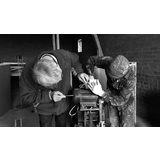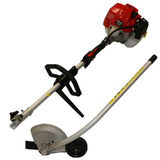Australia's wood manufacturing sector generates more than $2.2 billion annually, yet Australian woodworkers are opting for custom, handmade furniture over mass-produced furniture. Weekend warrior on your rural property or commercial arborist, chainsaw milling is a cost-effective solution to convert raw logs to workable timber without the expense of commercial sawmilling facilities. If you're looking to purchase the best chainsaw mills for your next project, check out the Chainsaw Mills collection for a variety of options available for Australian woodworkers.
This comprehensive guide has everything when it comes to chainsaw milling in Australia – from selecting the right gear to mastering the technique.
What is Chainsaw Milling?
Chainsaw milling is the technique of cutting planks, slabs, or beams from logs with a chainsaw equipped with a special mill attachment. The mill attachment is placed on your bar and directs the chainsaw through the wood, delivering smooth, consistent cuts that cannot be achieved with a standard chainsaw.
Compared to fixed sawmills, chainsaw mills are light in weight, compact, and ideal for in-situ timber processing. This is perfectly adapted to Australian conditions – whether milling timber out in bush trails, working through fallen timber on your property, or creating custom slabs for furniture projects.
Why Choose Chainsaw Milling in Australia?
Chainsaw milling has certain advantages that make it ideally adapted to Australian woodworkers:
- Portability: Mill logs where they fall – ideal for off-grid properties and bush sites where it's not practical to transport big logs.
- Affordability: Chainsaw mills are a fraction of the cost of conventional sawmills, ideal for hobbyists and small operations.
- Customization: Cut slabs to your desired dimensions for live-edge furniture, specialty decking, or special architectural elements.
- Independence: Cut your own timber on your schedule, independent of commercial mills and transport fees.
- Versatility: They cover a wide range of woodworking requirements, from furniture making to sawing firewood.
Types of Chainsaw Mills Found in Australia
Knowing the various types of mills enables you to pick the most suitable tool for your projects:
Portable Chainsaw Mills
Lightweight portable mills are simple to move around and come with adjustable parts to cut logs of different sizes. They generally have easy setup but frequent readjustment may be necessary as you go through a log. For portable milling equipment, check out our Milling Equipment.
Best for: Remote locations, sporadic use, variable log sizes
Considerations: May require frequent re-alignment when cutting
Alaskan Chainsaw Mills
These popular mills hold onto your chainsaw bar, presenting a firm surface area for accurate cuts. Alaskan mills enjoy excellent mobility with good accuracy, and these are highly sought after by Australian woodworkers.
Best for: General-purpose milling, nice balance of mobility and precision
Considerations: Multiple sizes to accommodate your chainsaw and log size requirements
Drag Chainsaw Mills
Drag mills position themselves on your chainsaw bar itself and are perfect for larger logs that require precision. They are light in weight, easy to install, and hugely popular for this convenience.
Best for: Bigger logs, convenience of assembly for the user
Considerations: Ideal for beginners since it's easy to use
Stationary Chainsaw Mill Attachments
These sawmills offer maximum stability and precision by holding tight onto the log. Less portable than others, they offer increased accuracy for demanding jobs.
Best for: Larger projects, precision cuts, workshop use
Considerations: More costly but more stable and accurate
Bandsaw and Circular Saw Mill Attachments
Some specialized attachments transform your chainsaw setup into something closer to traditional mills, offering greater accuracy and smoother cut finishes for complex projects.
Best for: Pro use, accuracy work
Considerations: Usually marketed as whole sets with all the parts
How to Choose the Best Chainsaw Mill
The best mill depends on some key considerations:
Remember Your Project Size
Small projects: Portable or Alaskan mills work well
Big logs: Stationary or drag mills provide better stability
Professional use: Buy higher-capacity, heavier-duty ones
Log Size Matching
Ensure your mill is the right size for the diameter of logs you use most frequently. More powerful mills accept bigger logs but may be overkill for small jobs. If you’re considering the right mill for your logs, you can browse options in our Milling Equipment.
Think Portability versus Power Requirements
- High mobility required: Select light, portable models
- Workshop use: Stationary mills offer more precision
- Distant property usage: Find a balance between portability and adequate power
Think Frequency of Use
- Hobby projects: Entry-level mills suffice
- Normal use: Buy rugged, professional-grade models
- Commercial use: Opt for heavy-duty models to be used continuously
Equipment Basics for Chainsaw Milling
Success at chainsaw milling requires more than a mill attachment. Here is your equipment list:
Chainsaw Details
Choose a high-powered chainsaw for your mill-ing task:
- Small logs (30cm or smaller): Minimum 60cc engine
- Medium logs (30-60cm): 70-80cc preferred
- Large logs (60cm+): 90cc+ for effortless cutting
Stihl and Husqvarna chainsaws, supplied by Australian importers like Chainsaw Spares, have robust models backed by strong local service.
Chainsaw Mill Attachment
Select an attachment with bar length and engine power matched for your chainsaw. Insure that the clamping system is robust and simple to use for repeated performance.
Guide Rails and Setup Tools
- Guide rails: Essential for straight first cuts
- Leveling equipment: Assures accurate alignment
- Measuring tools: For repeated slab thickness
Specialized Chains
- Ripping chains: Designed exclusively for horizontal milling cuts
- Skip-tooth chains: Enhanced chip clearance for milling applications
- Semi-chisel chains: Cutting speed and durability balanced
Safety Equipment (Non-Negotiable)
- Protective eyewear: Guard against wood chips and dust
- Hearing protection: Chainsaws produce hazardous sound levels
- Dust masks: Guard against inhalation of airborne fine sawdust
- Chainsaw chaps: Guard against accidental leg contact
- Steel-cap boots: Foot protection critical
- Work gloves: Better grip and hand protection
Other Tools
- Wedges: Stop chainsaw binding on cut
- Chainsaw wrench: Chain tightening
- Bar oil: Keep chain properly lubricated
- Sharpening kit: Optimize best chain performance
Key Selection Criteria for Quality Mills
In purchasing chainsaw mills, give utmost priority to the following most important features:
Strong Construction Materials
Choose aluminum or steel construction mills. Aluminum has excellent strength-to-weight ratio, while steel has maximum strength for heavy-duty applications.
Frame Quality and Design
The frame will dictate mill longevity and cutting accuracy. Choose finely welded steel frames with low load flex. Higher quality construction ensures smooth cuts for years of service.
Strong Clamping Systems
A secure clamping system is essential for safety and accuracy. Choose styles that firmly attach to your chainsaw without slipping, but are easy to adjust and remove.
Brand Reputation
Choose mills from brands with good reputations for quality. Brands like Stihl have excellent Australian backing, while aftermarket options from quality suppliers provide budget-friendly alternatives.
Compatibility and Flexibility
Ensure your mill is adaptable to work on different bar lengths and can adjust to project requirements. Modular systems are a long-term value.
Step-by-Step Chainsaw Milling Process
Use the following steps to ensure your milling success:
1. Log Preparation
- Select straight-grain logs for best results
- Remove all bark, dirt, and debris
- Check for nails, wire, or other metal substance
- Bolt the log to a solid, level surface
2. Initial Setup
- Install guide rails with a level for perfect alignment
- Install your mill on the chainsaw according to manufacturer's directions
- Ensure that all connections are tight
- Fuel and bar oil the chainsaw
3. Making the First Cut
- Set the mill onto the guide rails
- Begin the chainsaw and allow it to warm up
- Make your first cut slowly and steadily
- This cut is from which all the other cuts are made relative to, creating the reference surface
4. Additional Milling
- Remove the guide rails and set the mill for the slab thickness desired
- Use initial cut level surface as your new reference
- Maintain feed rate consistent for silky cuts
- Regularly check chain sharpness and lubrication
5. Finishing and Maintenance
- Clean all sawdust off equipment
- Check chain tension and sharpen as needed
- Properly store mill components to prevent damage
Portable vs. Stationary: Making the Right Selection
The decision of whether or not to own a portable or fixed mill will be dependent on your personal needs:
Use Portable When:
- You are required to mill logs in various locations
- Budget is a top priority
- Storage is limited
- Projects use smaller, more manageable logs
Use Stationary When:
- Accuracy is most important
- You're cutting large amounts routinely
- Workshop room space
- Budget makes high initial investment affordable
Cost Factors
Portable mills are typically less costly initially but may require additional accessories. Stationary mills are more expensive initially but often feature more extensive feature sets. Look at long-term requirements when comparing prices.
Tips for Successful Chainsaw Milling
Improve Your Technique
- Examine wood grain: Select straight-grain logs for high-quality slab
- Keep chains sharp: Dull chains make coarse cuts and require more effort
- Feed at controlled rate: Steady, even feed results in optimum output
- Monitor bar oil: Proper lubrication avoids overheating and early wear
Safety Best Practices
- Never work alone in a secluded spot
- Have first aid kits on hand
- Keep escape routes free around your work site
- Take frequent breaks to avoid fatigue-related accidents
Optimize Efficiency
- Plan your cuts beforehand
- Process similar logs in batches to minimize set-up adjustments
- Keep spare chains sharpened and in reserve
- Keep tools and accessories close at hand
Tips for Maintenance and Longevity
Routine maintenance extends mill life and ensures consistent performance:
Routine Cleaning
Remove all sawdust and material after each use. Accumulated residue can affect moving parts and result in excessive wear.
Lubrication
Keep all moving parts well lubricated according to manufacturer recommendations. This prevents corrosion and reduces friction.
Storage
Store mills in dry locations to prevent rust. Protect with covers for long-term storage.
Inspection
Inspect all of the bolts, clamps, and moving parts for wear and damage on a regular schedule. Replace worn items before they impact performance or safety.
Where to Buy Quality Chainsaw Mills in Australia
When purchasing chainsaw mills, look at the following:
Local vs. Online Suppliers
Local distributors like Chainsaw Spares enjoy the advantages of local support, faster delivery, and familiarity with local conditions. Internet sources could enjoy wider availability but balance warranty and maintenance concerns.
What to Look For
- In-depth product description and specs
- Clearly outlined warranty terms and local service support
- Customer review from Australian users
- Affordable price with shipping
- Technical support and spare part availability
Research Before Buying
- Read customer reviews from comparable usage
- Compare specs for different models
- Check compatibility with your current chainsaw
- Think about long-term part and service availability
Is Chainsaw Milling for You?
Chainsaw milling is well-suited to many Australian uses:
Ideal for:
- Australian rural property owners handling fallen trees
- DIYers making specialty furniture
- Small timber operations
- Woodworkers looking for affordable lumber solutions
- Remote site applications
Look elsewhere if:
- You need high-volume processing
- Precision demands more than chainsaw mill capabilities
- Time pressure requires quicker processing techniques
Getting Started with Confidence
Chainsaw milling is extremely versatile and economical for Australian woodworkers. From making live-edge slabs for furniture production to taking timber for construction projects, or just managing trees on your property, the correct mill configuration renders professional-quality results a real possibility.
Start off with top-grade equipment intended to suit your specific needs, prioritize safety at all times, and don't hesitate to seek advice from experienced operators. With proper technique and gear, you'll be turning logs into usable timber with excellent results.
Interested in learning about chainsaw milling options? Buy the entire range of chainsaw mills, attachments, and accessories available from Australian suppliers, and embark on the path to timber processing independence.
















